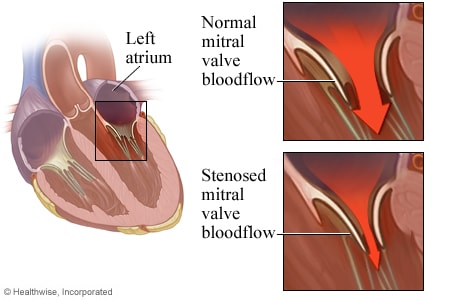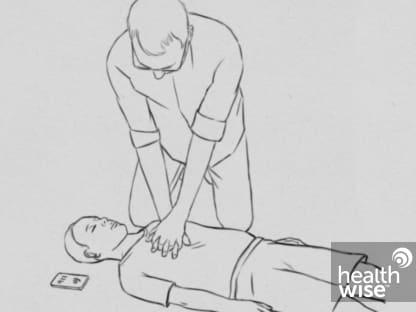Mitral Valve Stenosis
Make an Appointment
Our team is here to help you make an appointment with the specialists that you need.
Mitral Valve Stenosis
Condition Basics
What is mitral valve stenosis?
Mitral valve stenosis is a heart problem in which the mitral valve becomes stiff and doesn't open as wide as it should. This forces your heart to work harder to pump blood through the valve, which can weaken the heart and cause other problems.
What causes it?
Nearly all cases of mitral valve stenosis are caused by rheumatic fever. This fever results from an untreated strep infection, often strep throat. But many people who have mitral valve stenosis don't realize that they had rheumatic fever. Less common causes include other health conditions and calcium buildup on the mitral valve.
What are the symptoms?
Symptoms may not appear until you've had mitral valve stenosis for many years. An early symptom is shortness of breath when you're active. Later in the disease, you may feel short of breath even when you're resting. You may also feel tired and weak.
How is it diagnosed?
If you have mitral valve stenosis, your doctor may hear a heart murmur during a routine checkup. A test called an echocardiogram is used to find out for sure. You may also have an electrocardiogram, a chest X-ray, or other tests.
How is mitral valve stenosis treated?
Your doctor will check your heart regularly. Your doctor will recommend a heart-healthy lifestyle. You may take medicine to help treat or prevent other problems that can happen. If you have symptoms or severe stenosis, you may have a procedure to stretch the valve open or surgery to repair or replace the valve.
Cause
Nearly all cases of mitral valve stenosis are caused by rheumatic fever, which can follow an untreated strep throat infection. But many people who have mitral valve stenosis don't realize that they had rheumatic fever.
Less common causes include:
- A congenital (from birth) heart defect.
- Infection of the valve or heart muscle (endocarditis).
- Calcium buildup on the valve.
- Conditions that cause scarring of the valve, such as lupus or rheumatoid arthritis.
Learn more
Symptoms
Mitral valve stenosis symptoms may not happen for many years. When symptoms first appear, they usually are mild.
An early symptom is shortness of breath when you're active. This shortness of breath may seem normal to you.
Symptoms later in the disease may include:
- Shortness of breath even when you haven't been very active or when you are resting.
- Feeling very tired or weak.
What Happens

Mitral valve stenosis is a heart condition in which the mitral valve fails to open as wide as it should. When this happens, not as much blood can flow from the left atrium to the left ventricle. Over time, mitral valve stenosis can cause the left atrium to work harder to pump blood through the narrowed valve.
Mitral valve stenosis can lead to heart failure and complications such as heart rhythm problems (like atrial fibrillation), fluid buildup in the lungs, and stroke.
When to Call a Doctor
Call 911 or other emergency services immediately if you have:
- Symptoms of a heart attack, including chest pain or pressure.
- Symptoms of stroke or transient ischemic attack (TIA).
- Irregular heartbeats along with fainting episodes or lightheadedness.
- Palpitations.
- Shortness of breath.
- Coughing up blood.
Call a doctor now if you have:
- Symptoms of heart failure, such as shortness of breath, swelling in the feet and ankles, and not being able to exercise at your usual level.
- Mitral valve stenosis and are having symptoms of infection, such as fever with no other obvious cause.
- Fainting episodes.
- Excessive fatigue without another explanation.
Watch
Exams and Tests
Mitral valve stenosis may not be diagnosed until you've had the disease for some time. If you don't have symptoms, the first clue might be a heart murmur that your doctor hears during a routine checkup.
Your doctor will ask you questions about your past health and do a physical exam. If your doctor thinks that you might have the disease, you may need more tests. These may include:
- An echocardiogram (echo). This ultrasound test lets your doctor see a picture of your heart, including the mitral valve.
- An electrocardiogram (EKG or ECG). This test can check for problems with your heart rhythm.
- A chest X-ray. This shows your heart and lungs. It can help your doctor find the cause of symptoms such as shortness of breath.
These tests also help your doctor find what caused the stenosis and how severe it is.
Learn more
Treatment Overview
Treatment for mitral valve stenosis depends on how severe the disease is and if you have symptoms or other health problems from the stenosis. You and your doctor can decide what treatment is right for you.
- You will have regular checkups and echocardiograms if your stenosis is mild or moderate.
- Your doctor will likely recommend a heart-healthy lifestyle.
- You may take medicines to prevent or treat complications. These include atrial fibrillation, heart failure, and stroke.
- You may choose to have the mitral valve repaired or replaced if you have symptoms or the stenosis is severe.
Valve repair or replacement
Repairing the valve can be done by:
- Balloon valvuloplasty. This is a catheter procedure. It stretches the valve open. It is also called valvotomy.
- Commissurotomy. This is typically an open-heart surgery to remove calcium deposits and other scar tissue from the valve.
Mitral valve replacement surgery replaces the damaged valve with a new valve.
Self-Care
You can live a full and active life by doing things that help keep your heart and body healthy. Here's how.
- Have a heart-healthy lifestyle.
- If you smoke, try to quit. Medicines and counseling can help you quit for good. Avoid secondhand smoke too.
- Eat heart-healthy foods. These foods include vegetables, fruits, nuts, beans, lean meat, fish, and whole grains. Limit things that aren't so good for your heart, like sodium, alcohol, and sugar.
- Be active but don't start an exercise program on your own without talking with your doctor first. You may need some tests to see what kind and level of exercise is safe for you. Try for at least 30 minutes of activity on most days of the week. If activity is not likely to cause health problems, you probably do not have limits on the type or level of activity that you can do. If your condition is severe, your doctor will likely advise you to avoid strenuous activity.
- Stay at a healthy weight. Lose weight if you need to.
- Manage other health problems. These include diabetes, high blood pressure, and high cholesterol. If you think you may have a problem with alcohol or drug use, talk to your doctor.
- Take care of yourself.
- Call your doctor right away if you have new symptoms or symptoms that get worse.
- Go to your checkup appointments. And get the tests you need to assess your heart, such as echocardiograms.
- Take your medicines exactly as prescribed. Call your doctor if you think you are having a problem with your medicine.
- Practice good dental hygiene, and have regular checkups. Good dental health is especially important. That's because bacteria can spread from teeth and gums to the heart valves.
- Get a flu vaccine every year. And get a pneumococcal vaccine. If you've had one before, ask your doctor if you need another dose. Stay up to date on your COVID-19 vaccines.
- Talk with your doctor if you have concerns about sex and your heart. Your doctor can help you know if or when it's okay for you to have sex.
Learn more
Watch
Surgery
You may choose to have the mitral valve repaired or replaced. The goal is for blood to flow more normally through the valve. This helps relieve symptoms and ease the workload on the heart.
- Balloon valvuloplasty.
This procedure repairs the valve. A doctor uses a catheter in a blood vessel and a tiny balloon to stretch open the narrowed valve. It's less invasive than open-heart surgery. It's also called valvotomy.
- Surgery.
Valve repair surgery (commissurotomy) is typically an open-heart surgery. A surgeon removes calcium deposits and other scar tissue from the valve leaflets to widen the valve.
Valve replacement surgery might be done if the valve is damaged beyond repair. A mechanical or tissue valve will be used to replace your heart valve. This surgery most often is an open-heart surgery.
Learn more
Watch
Credits
Current as of: July 31, 2024
Author: Ignite Healthwise, LLC Staff
Clinical Review Board
All Healthwise education is reviewed by a team that includes physicians, nurses, advanced practitioners, registered dieticians, and other healthcare professionals.
Current as of: July 31, 2024
Author: Ignite Healthwise, LLC Staff
Clinical Review Board
All Healthwise education is reviewed by a team that includes physicians, nurses, advanced practitioners, registered dieticians, and other healthcare professionals.
This information does not replace the advice of a doctor. Ignite Healthwise, LLC, disclaims any warranty or liability for your use of this information. Your use of this information means that you agree to the Terms of Use. Learn how we develop our content.
To learn more about Ignite Healthwise, LLC, visit webmdignite.com.
© 2024-2025 Ignite Healthwise, LLC.
This information does not replace the advice of a doctor. Ignite Healthwise, LLC, disclaims any warranty or liability for your use of this information. Your use of this information means that you agree to the Terms of Use. Learn how we develop our content.











